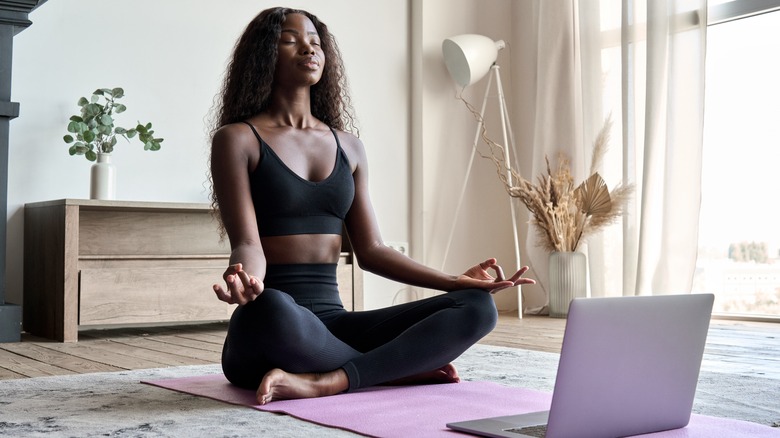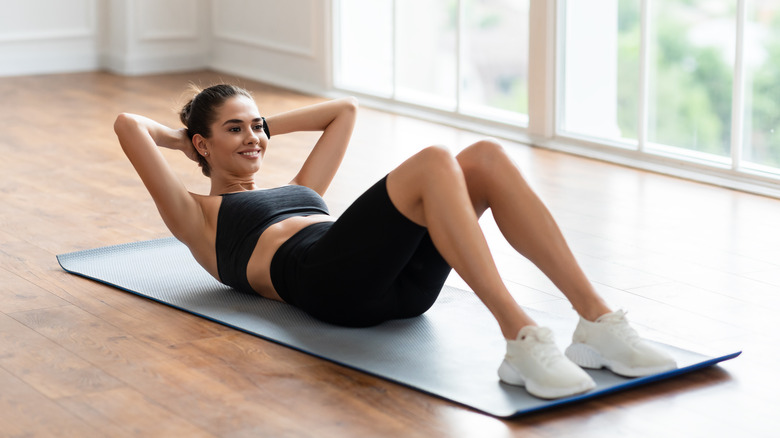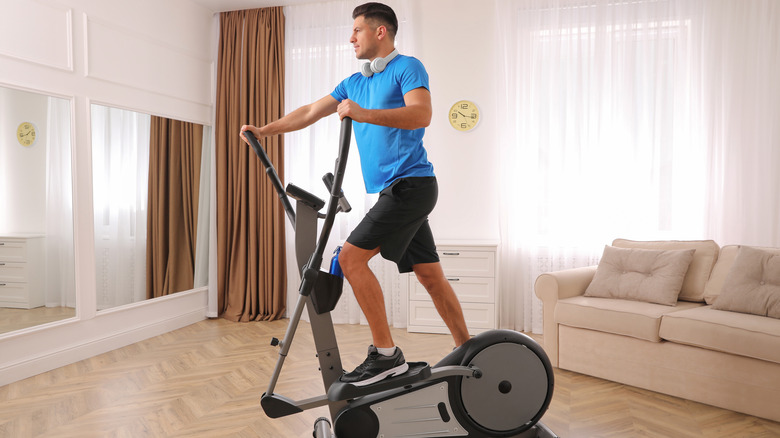A Fitness Expert Weighs In On How To Build The Best Workout Routine For Yourself
Working out is an essential part of a healthy and well-balanced lifestyle. As a matter of fact, getting regular exercise and physical activity can help improve and maintain the health of both your body and your mind. Not only can working out boost your energy, increase your muscle strength, and help you maintain your body weight, but it can also help enhance your mood and concentration. Sticking to a regular workout schedule, however, can sometimes be easier said than done. That's why it's best to start off small.
"Begin where you are at. If you have been sedentary, the first step is decreasing the time spent sitting and increasing the time active every hour," Anna Valdes, Ed.D, an exercise science educator and a fitness professional at the University of Central Florida, says in an exclusive interview with Health Digest. "To start, keep track of how long you sit during waking hours. Then try to decrease that time every day."
What to know about making your own workout routine
According to Valdes, physical activity can be divided into three main categories: aerobic exercise, strength training, and activities of daily living. These three categories are important factors to consider when creating your own personal workout routine. Activities of daily living is a term that refers to the energy you expend simply going about your day. "The best way to think about physical activity for health is to visualize physical activity as a pyramid. The bottom of the pyramid, the base, includes all the activities of daily living," Valdes says.
This can include walking to your car after work, using the stairs instead of the elevator, or simply taking the long way when walking to a certain destination. The next level is moderate-intensity aerobic exercise, which can include activities like dancing, riding a bicycle, or even taking a brisk walk. They can be done anywhere from three to five times a week. "Lastly, after the base and the aerobics become a habit, add strength training and flexibility activities," she shares. Some common strength training exercises include crunches, planks, push-ups, and squats, which should be done two to three times per week.
Easy workouts for those who are out of shape
If you're not used to working out or maintaining a regular workout schedule, Valdes recommends working on the base of the exercise pyramid by focusing on and prioritizing your activities of daily living. Instead of expending your energy all at once, however, take a few small breaks throughout the day to get in some light exercise.
Valdes says that the most important thing is that you get active and reduce the amount of time you spend sitting down every hour during the day. You can do this by taking at least five minutes every hour to dance, march in place, perform jumping jacks, or even go for a walk. "The point is to move and not sit," Valdes explains. "Moving and not sitting will increase your active minutes and by doing just 5 minutes every hour while awake, you can improve not only your health but the number of years that you stay disease free."
Quick workouts for those short on time
If you don't have a lot of time in your schedule to work out, however, you can also start off by exercising for just five minutes at a time. After you've mastered this, you can move on to the next level of the exercise pyramid, which is aerobic exercise. In order to stick to a regular routine, Valdes says that it's best to set up a specific time to work out and get in some aerobic exercise, like walking, biking, swimming, or jumping rope. Keep in mind, it's good to add in some strength training to your workout routine.
"For a simple strength training home program, try squats (sit and stand from a chair), lunges, push-ups, and crunches," Valdes shares. "To begin, use just body weight first, after you can do more than 15 repetitions (2 to 3 sets), pick up some weights." If you don't have any workout equipment, you can use heavy everyday objects, like milk gallons or water bottles.
Tips on how you can get more active
To get more active, Valdes suggests getting in more reps and sets and increasing the overall amount of time you spend working out. That being said, you should still start off small with just five to 10 minutes of exercise per day. "Every bit counts," Valdes says. Once you've gotten the hang of this, you can begin to get more active and gradually increase the length of your daily and weekly workout routine.
For instance, you can start by working out for 50 to 75 minutes per week. This can help get you in the habit of working out on a regular basis, Valdes explains. After that, you can move on to at least 40 minutes of exercise per day. Eventually, this should accumulate to more than 150 minutes per week. "The goal for Americans is to not be sedentary," she shares. "Sedentary behaviors increase the risk of chronic diseases, disability, and shorten lifespan."
How often you should work out
According to recommendations from the Centers for Disease Control and Prevention (CDC), the average American should engage in 150 minutes of moderate-intensity aerobic exercise every week. You should also engage in strength training for at least two days a week. "For those previously sedentary, they should start small and progressively build up to those 150 minutes," Valdes explains. "After that goal has been achieved, add muscle-strengthening activities."
The most important thing to remember, however, is that exercise doesn't have to be complicated in order to be effective in toning your body or improving your health. You just need to do it every day or most days, at least. "Daily physical activity will not only increase your lifespan, but it will also increase your health span — the number of years you remain disease free," Valdes adds. "So get moving!"
To find out more about Anna Valdes, visit the University of Central Florida.






